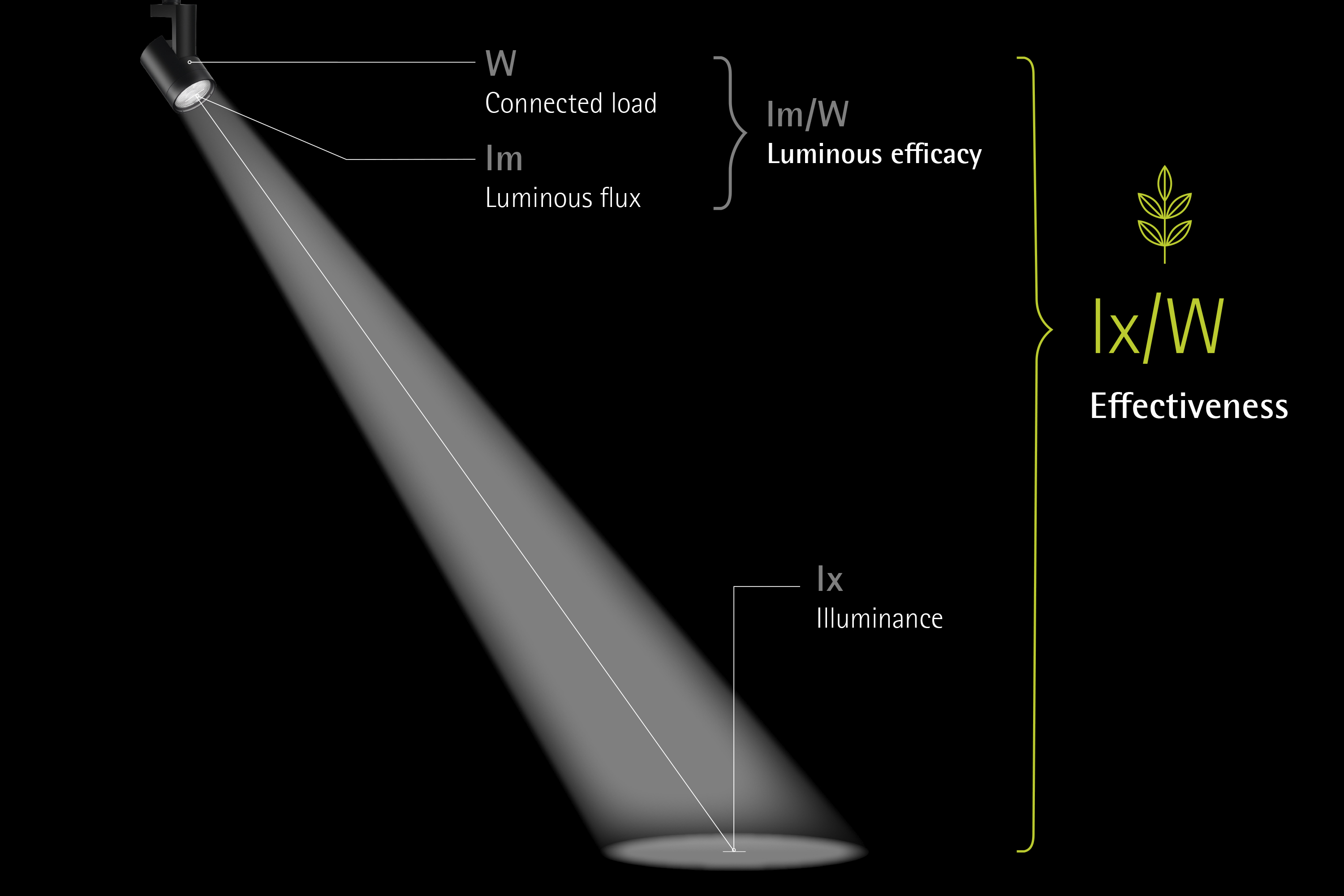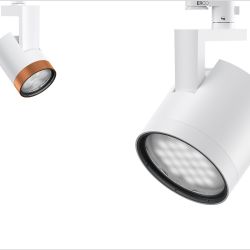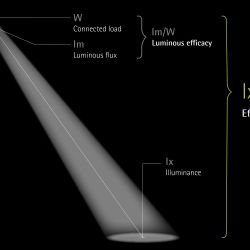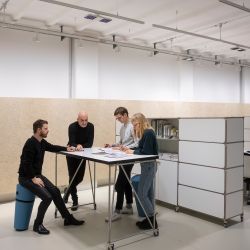
Download this article:
The last decade has been a transformational time in lighting. LEDs have taken over every application, and nowadays their efficiency and low cost lumens are taken for granted. But the big improvements brought by LEDs may have lured the lighting industry into some bad habits. Many have become quick to use blanket illumination and tolerate spill light in the knowledge that ‘LEDs are really efficient’. But now, with the climate crisis pushing sustainability to the top of the agenda and energy prices at record highs, it’s becoming clear that no-one can no longer afford to be complacent.
It appears that the time has arrived to fundamentally reappraise the standard approach to lighting design. Lighting experts from ERCO have recognised this need for a reassessment of our assumptions, and have been considering this issue for some time. The conclusion? The focus needs to switch to the effectiveness of the light in a space.
Efficiency is no guarantee of sustainability
Those designing lighting for a space need to choose carefully where to illuminate, and to think in terms of the illumination that’s achieved in lux/watt rather than the efficiency of the light fitting in terms of luminaire lumens/watt.
Specifically, what’s being advocated is a combination of low glare, precisely-targeted task lighting and a general movement towards the illumination of vertical surfaces over the floor. It’s about directing light exactly where it’s needed for tasks and where it’s most effective for human perception – and reducing it everywhere else.
Energy is a limited and expensive resource. So those planning with light need to be more effective with the light and decide where to not put energy, because that’s where the savings will be found. This approach can lead to a big reduction in the connected load. Done well, it can substantially reduce energy consumption because it only puts light where it’s needed.
This reduction of light in certain places is balanced by an increased emphasis on people-centric lighting designed for visual comfort. A key part of this is switching the focus from the floor to the vertical surfaces. To make a space feel bright, the walls need to be illuminated as that’s what’s in the visual field.
‘If 100lx is put on the wall instead of the floor, the room feels three to five times brighter – just by illuminating a different surface.’
Better lighting with half the energy
Historically, walls haven’t been prioritised, although the latest version of the European indoor lighting standard EN 12464-1 now takes it more seriously.
In an office, for instance, the strategy of guiding light where human perception requires it would dictate that light is delivered to the desktops, if that’s where light is required. In a 100 square metre office, desks could take up 20 square metres of the space. If you light the walls and the desks only, then compared to uniform blanket illumination, about half the energy could be saved while creating a better and apparently brighter visual space for people.
The design rethink began with spotlights because they are, after all, all about putting light exactly where it’s needed. Many spotlights available on the market use a combination of chip-on-board (CoB) LED modules with reflectors. The combination achieves a good luminaire lumen/watt measurement, but these generate a large uncontrolled corona of light around the beam and in the end the stray light is wasted light. Much of the light coming from the CoB modules isn’t hitting an optical system, and consequently it goes everywhere. Additionally, the very act of reflection results in a reduction of light.
ERCO spotlights, by contrast, use lens systems with single high-powered chips. This tiny but bright point of light is much easier to control into a narrow beam of effective light. ERCO mounts the chips themselves into their own printed circuit boards before pairing them with a bespoke lens design.
Although this construction has nominally lower lm/W values, it brings up to 20 per cent more light to the target surface compared to rivals. This means that planners who only look at the lm/W values on a luminaire's technical data sheet are giving away the potential for sustainable lighting focusing on more light on the target area as well as for energy savings.
The lx/W metric is the key to effectiveness
The latest generation of the ERCO Parscan spotlight for instance may have a high lumen-to-watt ratio of 105lm/W, but it’s in its ultra-high lx/W metric compared to other luminaires that its effectiveness is really proved.
One additional important component to the philosophy is the avoidance of glare. If there is glare, the visual contrast is lowered and consequently more light needs to be added to the task. After all, glare is by definition wasted light.
The combination of effectively targeted light and high visual comfort for people may sound simple at first glance, but in its implementation it can be radical. But with the climate crisis looming, and those lumens no longer cheap, a radical approach that recalls perception-oriented lighting design with high visual comfort is probably just what is needed.
(5278 Characters)About ERCO
The ERCO Light Factory in the German town of Lüdenscheid is a leading international specialist in architectural lighting using LED technology. The family business, founded in 1934, now operates as a global player with independent sales organisations and partners in 55 countries worldwide. Since 2015, ERCO’s portfolio has been 100% LED. With this in mind, ERCO in Lüdenscheid develops, designs and produces digital luminaires with focus on photometrics, electronics and design. Working closely with architects, lighting designers and engineers, ERCO develops lighting tools used primarily for applications in the following fields: Work and Culture, Community and Public/Outdoor, Contemplation, Living, Shop and Hospitality. ERCO understands digital light as the fourth dimension of architecture – providing highly precise and efficient lighting solutions to support creative designers in turning their visions into reality.
If you require any further information on ERCO or image material, please visit us at press.erco.com/en. We can also provide you with material on projects worldwide for your media coverage.
Relevant image material
© ERCO GmbH, www.erco.com
ERCO spotlights are maximally effective thanks to dedicated lighting technology. Parscan InTrack spotlights deliver up to 50% more light to the target area than other spotlights with comparable connected load. The best prerequisite for sustainable lighting.
© ERCO GmbH, www.erco.com
How much light actually reaches the area relevant for human perception (lx/W)? Illuminance is the indicator for sustainable lighting. ERCO spotlights set the standard here.
© ERCO GmbH, www.erco.com
Human Centric Lighting is a planning attitude. It places people, their needs and activities at the centre of lighting design. This means that light is deliberately used only where human perception requires it. A key element of sustainable lighting.
© ERCO GmbH, www.erco.com, Photography: Sebastian Mayer
Zonal lighting tailored to user needs and architectural effect is the planning approach for sustainable lighting. Despite low connected load, a bright room impression is created.



